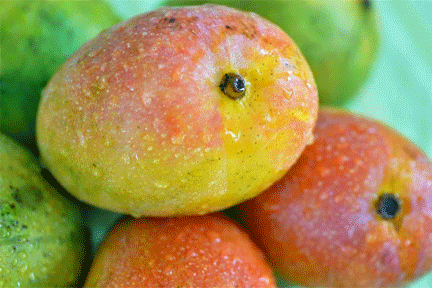‘Mango mágico’: How the fruit became part of Mexican cuisine
News Category: News and Food and Drink
-
Published May 29, 2023
Can you guess what is a close botanical cousin to cashews and pistachios? Did you guess walnuts, perhaps almonds? You may be surprised to learn that the mango actually belongs to the same anacardiaceae (sumac) family of plants.
The mango shows up everywhere in Mexican cuisine: from mango salsa, mango tamales, mango empanadas, mango ceviche, mango margaritas, to mango sorbet… you’d be hard-pressed to find a Mexican staple that isn’t elevated by the mighty mango.
Believed to be native to South Asia, the cultivation of mangos can be traced back as early as 2000 B.C.E. in India. The mango tree, with its broad evergreen leaves and fragrant flowers, became a symbol of love and fertility in Indian mythology and was often referred to as the “king of fruits.”
Over time, the popularity of mangos spread across different regions of Asia. Indian traders introduced the fruit to Southeast Asia, including Burma (now Myanmar) and Thailand, where it thrived in the tropical climate. From there, it made its way to the Philippines and Malaysia, becoming an integral part of the local cultures and cuisines. You might be wondering, when does Mexico come into the picture?
Mangos arrived in Mexico during the 16th century, brought by the Spanish. It turns out the favorable climate allowed mango cultivation to thrive. Over time, Mexico became a leading producer and exporter of mangos, with diverse varieties that have become integral to Mexican cuisine.
In the United States, mangos were first introduced in Florida in the early 19th century, but it wasn’t until the mid-20th century that commercial cultivation took off.
‘Mango mágico’: How the fruit became part of Mexican cuisine
Stephen Randall
May 26, 2023Mangos may be native to Asia, but Mexican cuisine is full of dishes that incorporate the versatile fruit. (Sader)
23SHARES
Can you guess what is a close botanical cousin to cashews and pistachios? Did you guess walnuts, perhaps almonds? You may be surprised to learn that the mango actually belongs to the same anacardiaceae (sumac) family of plants.The mango shows up everywhere in Mexican cuisine: from mango salsa, mango tamales, mango empanadas, mango ceviche, mango margaritas, to mango sorbet… you’d be hard-pressed to find a Mexican staple that isn’t elevated by the mighty mango.
Mango season stretches from February to August in Mexico. (Shutterstock)
Believed to be native to South Asia, the cultivation of mangos can be traced back as early as 2000 B.C.E. in India. The mango tree, with its broad evergreen leaves and fragrant flowers, became a symbol of love and fertility in Indian mythology and was often referred to as the “king of fruits.”Over time, the popularity of mangos spread across different regions of Asia. Indian traders introduced the fruit to Southeast Asia, including Burma (now Myanmar) and Thailand, where it thrived in the tropical climate. From there, it made its way to the Philippines and Malaysia, becoming an integral part of the local cultures and cuisines. You might be wondering, when does Mexico come into the picture?
Mangos arrived in Mexico during the 16th century, brought by the Spanish. It turns out the favorable climate allowed mango cultivation to thrive. Over time, Mexico became a leading producer and exporter of mangos, with diverse varieties that have become integral to Mexican cuisine.
In the United States, mangos were first introduced in Florida in the early 19th century, but it wasn’t until the mid-20th century that commercial cultivation took off.
Sweet, smooth and just a touch sour, mangos are a mainstay of the Mexican diet. (Wikimedia Commons)
The 20th century also saw significant advancements in mango breeding and research.Scientists developed techniques to improve the quality and yield of mango trees, resulting in new varieties with desirable traits, such as disease resistance and extended shelf life. These advancements have contributed to the global availability and popularity of the fruit throughout the year.
Mangos have been celebrated not only for their taste but also for their cultural significance. The fruit has inspired numerous works of art, literature, and songs in different cultures.
In India, mango festivals and competitions are held to showcase the best varieties, while in other countries, such as the Philippines, the mango is considered a national fruit. In fact, one of the most popular varieties of mango is called Manila, named after the capital of the Philippines. The Manila mango gained popularity for its unique flavor, smooth texture, and lack of fibers, making it a highly sought-after variety in both local and international markets.
On to one of my favorite uses of mango in the kitchen – mango habanero hot sauce! The co-stars of this recipe play off of each other exceptionally well.
-


Leave a Reply